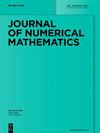Efficient numerical solution of the Fokker-Planck equation using physics-conforming finite element methods
IF 4
2区 数学
Q1 MATHEMATICS
引用次数: 0
Abstract
Abstract We consider the Fokker–Planck equation (FPE) for the orientation probability density of fiber suspensions. Using the continuous Galerkin method, we express the numerical solution in terms of Lagrange basis functions that are associated with N nodes of a computational mesh for a domain in the 3D physical space and M nodes of a mesh for the surface of a unit sphere representing the configuration space. The NM time-dependent unknowns of our finite element approximations are probabilities corresponding to discrete space locations and orientation angles. The framework of alternating-direction methods enables us to update the numerical solution in parallel by solving N evolution equations on the sphere and M three-dimensional advection equations in each (pseudo-)time step. To ensure positivity preservation as well as the normalization property of the probability density, we perform algebraic flux correction for each equation and synchronize the correction factors corresponding to different orientation angles. The velocity field for the spatial advection step is obtained using a Schur complement method to solve a generalized system of the incompressible Navier–Stokes equations (NSE). Fiber-induced subgrid-scale effects are taken into account using an effective stress tensor that depends on the second- and fourth-order moments of the orientation density function. Numerical studies are performed for individual subproblems and for the coupled FPE-NSE system.用符合物理条件的有限元方法求解Fokker-Planck方程
摘要本文考虑光纤悬浮液取向概率密度的Fokker-Planck方程(FPE)。利用连续伽辽金方法,我们用拉格朗日基函数来表示数值解,拉格朗日基函数与三维物理空间中的一个域的计算网格的N个节点和代表位形空间的单位球面表面的网格的M个节点相关联。我们的有限元近似的NM时间相关未知数是对应于离散空间位置和方向角的概率。交替方向法的框架使我们能够通过在每个(伪)时间步上求解N个球面上的演化方程和M个三维平流方程来并行地更新数值解。为了保证正性保持和概率密度的归一化性质,我们对每个方程进行代数通量校正,并同步不同取向角对应的校正因子。用Schur补法求解不可压缩Navier-Stokes方程组,得到了空间平流阶的速度场。使用依赖于方向密度函数的二阶和四阶矩的有效应力张量来考虑纤维诱导的亚网格尺度效应。对单个子问题和耦合FPE-NSE系统进行了数值研究。
本文章由计算机程序翻译,如有差异,请以英文原文为准。
求助全文
约1分钟内获得全文
求助全文
来源期刊
CiteScore
5.90
自引率
3.30%
发文量
17
审稿时长
>12 weeks
期刊介绍:
The Journal of Numerical Mathematics (formerly East-West Journal of Numerical Mathematics) contains high-quality papers featuring contemporary research in all areas of Numerical Mathematics. This includes the development, analysis, and implementation of new and innovative methods in Numerical Linear Algebra, Numerical Analysis, Optimal Control/Optimization, and Scientific Computing. The journal will also publish applications-oriented papers with significant mathematical content in computational fluid dynamics and other areas of computational engineering, finance, and life sciences.

 求助内容:
求助内容: 应助结果提醒方式:
应助结果提醒方式:


